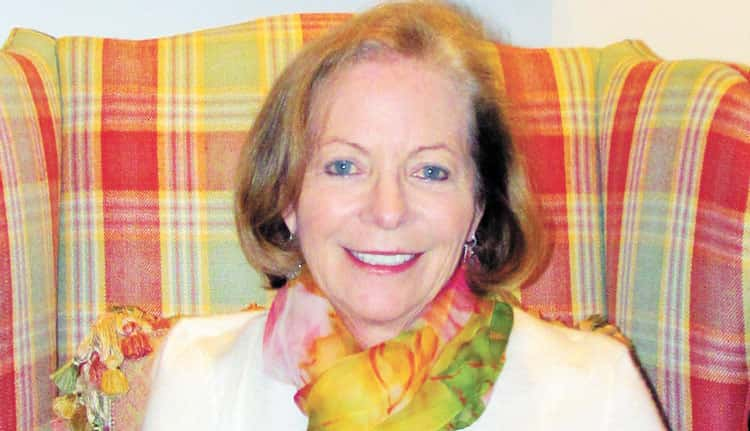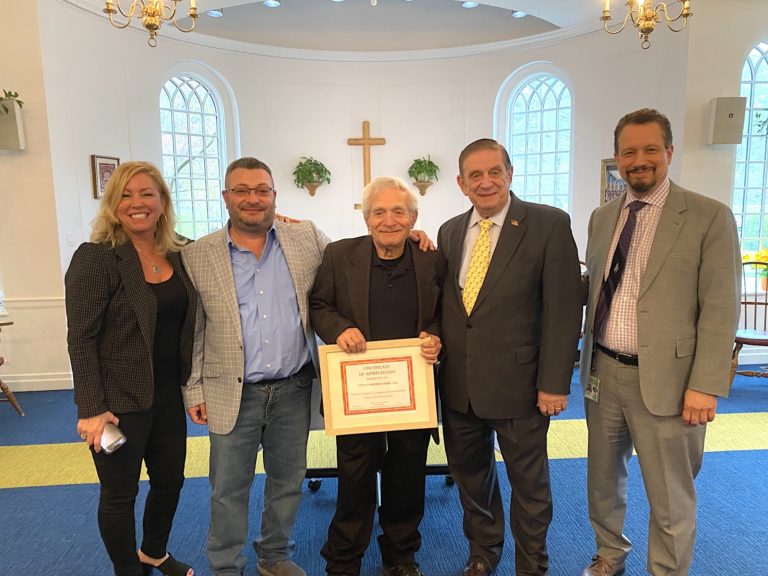

By Anne W. Semmes
Sentinel Correspondent
Patricia Walsh Chadwick of Greenwich is every inch an entrepreneur, with a 30-year career in the financial world. She succeeded in a man’s world, traveled the world as a Global Partner of INVESCO, created her own Ravensgate consulting firm, often opined on markets on CNBC, and picked up a YWCA Brava Award along the way.
What were her formative influences? Surviving a painful childhood in a religious cult, separated from her parents and four siblings, until she was ejected at age 17 into the world with no money, skills or family support, a stranger to newspapers, magazines, television, and the simple act of making a phone call.
The astounding story is all there in words and pictures in her new memoir, Little Sister, soon to be in bookstores in April, published by Post Hill Press. One sees today Chadwick, well married to John Chadwick and a mother of grown up twins, still working and active in the nonprofit world.
For a glimpse of her singular experience, we asked Chadwick a few questions:
GS: From the age of six you lived amongst 39 children in a Catholic community, the Slaves of the Immaculate Heart of Mary outside of Cambridge, Massachusetts, overseen by well-educated adults, including your parents. What was the draw for them?
PC: The original draw was the Saint Benedict Center near Harvard and Radcliffe where Catholics, young students and young professionals could meet, talk and listen to intellectual lectures. It morphed into something very different when the spiritual leader of the Center, Father Leonard Feeney, a renowned Jesuit, took a very strong point of view about the dogma of the Catholic faith that said outside of the Catholic Church, there is no salvation. He was soon excommunicated.
GS: What drew your parents to follow him?
PC: They supported his point of view. They were among 51 young men and women who created this religious order, the Slaves of the Immaculate Heart of Mary, in January of 1949, which was separate from Saint Benedict Center, but they became one and the same. Part of the vows they took was obedience to Father Leonard Feeney. At that time there were only three married couples with children, with fathers who were professors at Boston College. But over the next six or seven years the community would grow to 100 people, with 39 children.
GS: So what caused the separation of children from parents?
PC: There was a time when the couples each had their own little apartment, raising their own children, in their own way. We had all our meals together — everyone shared everything. Nobody had money of their own or possessions of their own. We all dressed alike. The separation was decreed by Father Feeney that children three years and older would no longer live with their parents. This took place when I was six years old. It was the most awful day of my life.
GS: And your parents went along with this new edict?
PC: They had no problem living a communal life, studying together, eating meals. But giving up their children, and, subsequently, no longer living as man and wife, they found painful. However, they accepted the separation because they had taken the vow to obey Father Feeney.
GS: Your community then moved house to property west of Cambridge, in the village of Still River. How often did you see your parents?
PC: Community meetings, as they were called, were an opportunity to visit with my family, which was maybe every three or four months. We sat in a little clan, very much a family. Otherwise, there was a prohibition about any child speaking to any grown-up. But my father had a variety of ways of communicating — one of which was he would take his little baby finger and wiggle it at me, and my sisters and my brother as well. I saw more of my mother, because I worked alongside her baking the desserts. She would give me a little wink from time to time just to let me know she was aware of my presence.

GS: The bête noire in those separation years for you was Sister Catherine?
PC: Sister Catherine (Catherine Clarke) was the founder of the Saint Benedict Center in 1940, who brought in Father Feeney. She bought the Still River property. As I turned from 12 to 13, I began to realize there was no way out. Sister Catherine started talking about religious life and the calling that we had to be religious. I would think to myself, “I haven’t been called to be religious,” but there was no way to say that out loud. When I turned 16, I became a postulant, the first step to becoming a nun.
GS: What were your coping mechanisms?
PC: I never let my fantasies or my imaginings disappear. In addition, because there was a huge amount of individual stress, a lot of my energies were dedicated to looking out for my three little sisters and my little brother. And even, at times, looking out for my parents — worrying about them. I grew up very, very young and I took these burdens on myself. That being said, Sister Catherine took great pains to make sure the parents could find out very little about what was going on. So when my sister Cathy had her eating problems, my parents were oblivious. A large measure of that was because Sister Catherine never gave us enough time to spend with them. If you only had 45 minutes every few months, by the time you talked about what you were doing in school or your favorite pet or something that was positive, the bell rang and the meeting was over.
GS: How did Sister Catherine perceive your growing resistance to a cloistered life?
PC: My innocent crushes on grown men in the community were an issue for her, because after I left she basically told people I was destroying the vocations of others. The mission that Sister Catherine spoke of — how we were to be dedicated to saving souls and willing to lay down our life for the Catholic faith was just falling on deaf ears with me. I had a different idea about what I wanted in my own life.
GS: Your brightness as a student began to make its impact. You became the instrument to getting the Center’s school accredited academically. You were directed to apply to and were accepted by Vassar and Bates colleges but not allowed to attend. Didn’t this provoke a sense of outrage and betrayal?
PC: For me, this was a mission to save the school and I put every ounce of my energy into succeeding. It was an exercise I was asked to take on after I was informed that I would be forced to leave. This was my home. These were the only people in the whole world I knew. I adored them.
GS: Your book describes your challenging path from your ejection at 17 to landing on your feet age 21 when you found your career in financing. What happened to that religious community?
PC: Two years after I left, Sister Catherine died. With her demise came, in essence, the breakdown of the entire community. Only with the benefit of decades since then did it strike me as this is what often happens in a cult-like environment — when the leader is gone there’s no glue that holds the place together.
GS: You reflect on your childhood with great pleasure…
PC: The life was very, very structured — the rules were onerous. I became accustomed to a life of silence. That being said, I loved school. It was a classical education, much more so than exists in general today. When you’re in a difficult environment you find what you love to do. Cooking and canning gave me a sense of peace and even now when I engage in those activities, I see myself back at the Center. Today, my friends know me as that wild woman canning in the fall.
GS: You dedicate your book, surprisingly, to your parents: “To Mother and Daddy, for always letting me know they loved me.”
PC: We as a family, I think, we’re extremely fortunate, perhaps more so than some other families. It was very evident that our parents loved us. But we had no pictures as a family with them after the ones from when I was a tiny child. But in a sense pictures are not the whole story. When once again we all came together as a family there was no yelling and screaming — there was no, “Why did you do this to us?’ There was a sense of having come back together as a whole, and as young adults we were dating and getting married. But my parents’ house was always the center for the whole family to come together. I have to express that I was not a miserable, unhappy child. I played hard. I had fun. I was creative. I was always getting into trouble, not so much because I broke rules and there were plenty of rules, but because I always had some crazy wild idea. And frankly, to this day, I still think I lead that kind of a life and my motto is better to ask for forgiveness than permission.
Patricia Walsh Chadwick’s new memoir, “Little Sister,” is available at the Christ Church Bookstore, with a book launch at the Bookstore on April 5, from 7:30 to 9 p.m., at 254 East Putnam Avenue. For more information call 203-869-9030.




